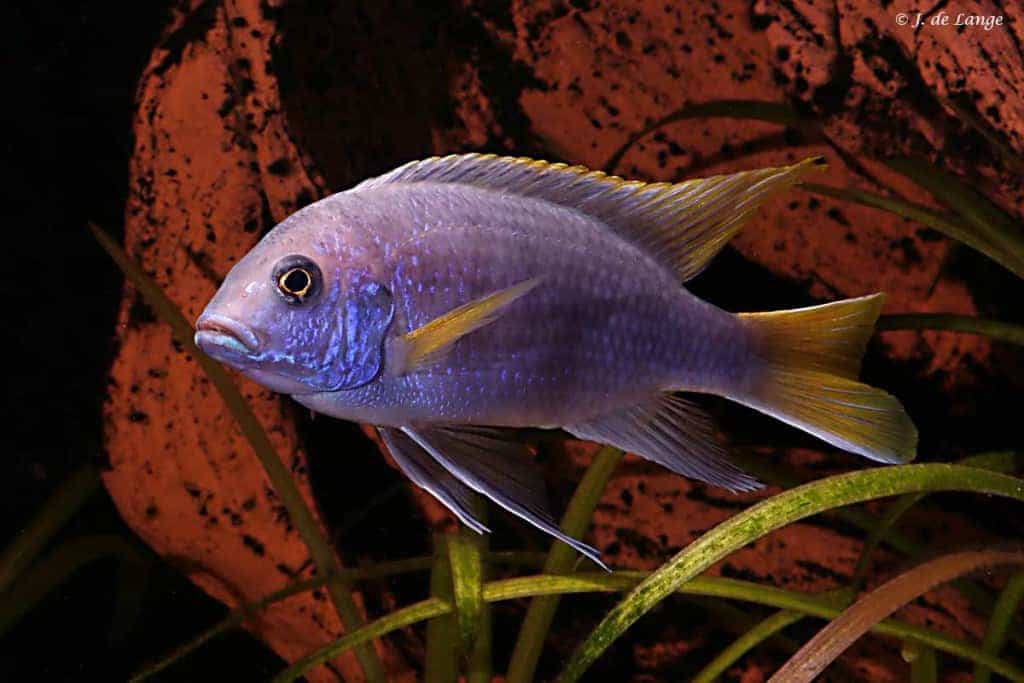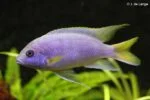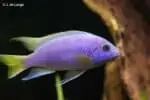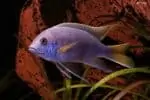Pseudotropheus sp. Acei
Despite the popularity of Pseudotropheus sp. Acei it has not yet been officially described. Hence the abbreviation sp. in the name. To indicate the difference from other variants, it is also called Pseudotropheus Acei Yellow Tail or Yellow Tail Acei. The name Acei was first mentioned by Ad Konings in 1989, before it was sold under the name Pseudotropheus penforti.
The origin of the given name Acei is not entirely clear, it is suspected that it comes from the English “Ace”; A winner for sales in the aquarium hobby. This came true because it is one of the most commonly kept species. The genus name Pseudotropheus in which they are at least temporarily housed can be divided into two words Pseudo meaning “false” and tropheus meaning “trophe” as a reference to the genus Tropheus from Lake Tanganyika.
Description
Pseudotropheus sp. Acei is predominantly blue/purple, with a metallic sheen on the head, gills and jaws. The fins are yellow. Unlike many other Mbuna, the caudal fin is forked. Unlike many other Mbuna, the tail fin is forked. The shape of the caudal fin suggests that it is more suited to open water than to a rock dweller. Rounded fins give more maneuverability between rocks, the forked fins are built more for speed.
In the wild they do not grow much larger than 12 centimeters in length. Because we feed more in the aquarium and also give them higher protein food, they can grow up to 18 centimeters in length.
Sexing
Telling males from females in Pseudotropheus sp. Acei, unlike many other Mbuna, is very difficult. Even in adults it is difficult to see. Both males and females have egg spots. The egg spots in the male are often slightly more numerous and brighter colored. The males grow slightly larger than the females and are slightly more intensely colored. The unpaired fins of males are slightly longer than those of females. Unlike many other Mbunas, the females’ unpaired fins are not rounded. The end runs into a point, just like with the males.

Behavior
For a Malawi cichlid, the Pseudotropheus sp. Acei is particularly friendly, they can even be kept very well in a school (preferably with more females than males). Not territorial, nor aggressive towards other species, but the species will snap away when they themselves are bothered. They can be combined well with most Malawi species, Mbuna, Aulonocara or the Utaka do not matter much to them. Due to the more powerful food with proteins, they will grow larger towards 18 centimeters in total length in an aquarium with Utaka.
Pseudotropheus sp. Acei “White Tail” Ngara – Acei Ngara
There is also a species called Pseudotropheus sp. Acei “White Tail” or Pseudotropheus sp. Acei Ngara. This is most likely a different species. These fish are more stocky in build, darker in color and have white fins. Dominant males have vertical stripes on the flanks. They are also a lot more aggressive than the “real” Acei. These 3 species together “Yellow Tail”, “White Tail” and Pseudotropheus elegans are very similar to the members of the Gephyrochromis genus. The only difference between these three and Gephyrochromis consists of the difference in teeth.
Biotope
You can only find Pseudotropheus sp Acei in Lake Malawi. They are generally found in fairly shallow water south of Nkhata Bay on the west coast of the lake in Malawi and Tanzania. The habitat usually contains tree stumps that have ended up in the water. They use the stumps as shelter and to eat the aufwuchs that grow on the tree stumps. In the absence of trees, they can also be found around the rocks in the water. Occasionally you will find them above bare sand, but this is not preferred.
Previously it was assumed that its range also extended further north. However, around Chilumba the Pseudotropheus elegans appears to be present. The Pseudotropheus sp. Acei Ngara (White Tail) is most likely a separate species.
Some locations where they can be found are: Chemwezi Rocks, Chimwalani Reef, Dwangwa, Luwala Reef, Msuli Point, Senga Bay.
Diet
In the wild, Pseudotropheus sp. Acei swims around trees that have fallen into the water. They eat the aufwuchs there and everything edible they can find around there. They therefore mainly ingest algae, supplemented with insect larvae and invertebrates.
It is therefore best to feed them in the aquarium with a mainly herbivorous diet. This can consist mainly of spirulina flakes or a green granulate, supplemented with crustaceans such as cyclops, shrimp (pieces), mysis and krill. Be careful with fatty and protein-rich food such as mosquito larvae or artemia. Definitely do not feed red mosquito larvae and tubifex, as this can cause Malawi Bloat.
In the aquarium it is not a fussy eater. In fact, they are voracious eaters who devour both vegetable food and live/frozen food. Due to the amount of food we usually give, the Pseudotropheus sp. Acei in the aquarium often grow larger than in the wild.
The Aquarium
The aquarium for a trio of Pseudotropheus sp. Acei doesn’t have to be very big. I would use a minimum of 120 centimeters, but then there is not much room to keep many other fish. If you want to keep more, it goes without saying that you will need a larger aquarium. More males together should not be a problem, but I would advise keeping more females than males.
Set up the aquarium with sand on the bottom. At the edges you can make rocks with some cracks, crevices and holes in between where fish can hide. The most important thing is that there is a lot of free swimming space. They don’t really form a territory between the rocks but usually just swim along them. If you use stone, make sure they are placed on a rubber or tempex subfloor. Pseudotroheus sp. Acei often digs a breeding hole to lay eggs. If it is right next to a stone, they will dig away all the sand, including the sand under the stone!
You can use plants such as Vallisneria, but make sure they are sturdy plants. The Acei is not very careful with plants and will dig them up occasionally. By the way, they don’t eat the plants.
Water parameters
As usual for Malawi cichlids, the water temperature may be between 22 and 26 degrees Celsius. They like slightly harder, alkaline water with a pH between 7.5 and 8.5 and a GH of 12 to 16. Because Pseudotropheus sp. acei is an active swimmer, there should be some current in the water.
Breeding Pseudotropheus sp. Acei
The cultivation of Pseudotropheus sp. Acei is fairly simple. The man digs a hole in the sand at the bottom of a rock. They can move a lot of sand, so make sure that the rocks are firmly secured and not loose on the sand.
To attract the female, the male spreads its fins widely. With trembling movements he shows his flank to the female. If the female is willing to mate, she accompanies him to the breeding pit. There they circle each other for quite some time. When the female is ready to spawn, she lays a few eggs, turns quickly and takes the eggs into her mouth. While circling each other, the male releases some of his sperm and fertilizes the eggs in the female’s mouth.
The fish are polygamous mouth brooders, with the female keeping the eggs and young in the mouth for about three/four weeks. After release, the young are independent and can be fed with dust food, young brine shrimp or crushed flakes. Soon they can handle cyclops too. Young fish are not safe from the parents – if one wants to keep a nest, the mother will have to be separated after two weeks of incubation. After the fry hatch, the parent fish will have to be removed from the young fish fairly quickly. They grow quite quickly (about an inch per month).
The young initially have a sand-colored camouflage. There is a stripe pattern on the flank, which disappears completely as they grow up.
Conclusion
Pseudotropheus sp. Acei is also a good choice for the novice Malawi enthusiast. They can easily be combined with other fish species. However, they are voracious eaters and can grow quite large if fed too much and too strong food. In an Mbuna aquarium with a lot of vegetable food and little live/frozen food, they remain significantly smaller.
Video
Authors
Serge
John de Lange
Copyright images
John de Lange
References
Seriouslyfish.com
Cichlidae.com
NVCweb.nl
My own experiences














Reviews
There are no reviews yet.